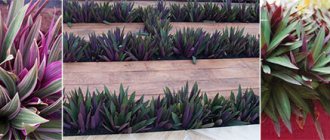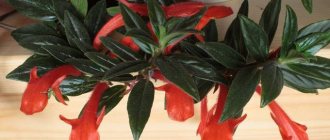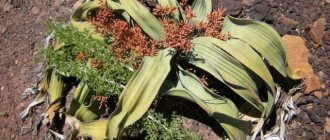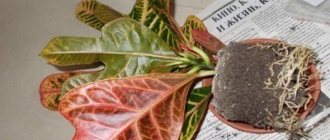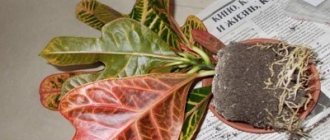Our mother nature is rich in different plants and each of them is unique. At the same time, quite often you can find cultures that are very similar to each other, for example, even the giant oak tree has an interesting double. It is noteworthy that a flower with leaves like an oak tree is also a tree, only very small and is an original indoor plant. The only similarity between them is the shape of the leaf blades, although it is very distant. At the same time, many gardeners remember the flower precisely for this reason. What kind of culture is this and what is so special about it?
A flower with leaves like an oak tree - an unsurpassed croton
Our mother nature is rich in different plants and each of them is unique. At the same time, quite often you can find cultures that are very similar to each other, for example, even the giant oak tree has an interesting double. It is noteworthy that a flower with leaves like an oak tree is also a tree, only very small and is an original indoor plant. The only similarity between them is the shape of the leaf blades, although it is very distant. At the same time, many gardeners remember the flower precisely for this reason. What kind of culture is this and what is so special about it?
Reproduction of Kalanchoe by brood buds (babies)
Answering the question of how Kalanchoe reproduces by brood leaf buds (babies), it should be noted that not all types of this succulent have them. Small daughter plants are formed on the leaves of the “viviparous” Kalanchoe. Other varieties of this flower do not form them. Kalanchoe babies have several leaves and roots. Adult succulents often independently shed brood buds, which take root at the foot of the mother plant. They can be planted in separate pots with fertile substrate. Fully formed shoots are carefully broken off from the adult leaf and buried slightly into the prepared substrate.
Flower with leaves like oak
Indoor oak - this is what croton, a plant from the euphorbia family, is sometimes called.
You don’t need to look far for the reason, because its leaves really look like oak. Croton grows in the form of a compact tree up to a maximum of 1 m in height. But to see its lush crown, you will have to wait more than one year, since the bush develops slowly. Only the shapes of the plates are remotely similar to oak. In decorative deciduous croton they have a denser structure and brighter color. The Latin name for croton is codiaum. It is noteworthy that it first forms green young leaves. They acquire variegation over time as they age.
Croton gained its popularity due to its varied and bright colors. The flower has about 14 varieties, and each of them, in turn, is distinguished by its originality and has many varieties. Most often in indoor floriculture you can find the following varieties of croton:
- Petra with green leaves and yellow veins;
- Miss Iceton with yellow-red-pink variegated leaves;
- Normal - with red veins and yellow spots on green leaves;
- Gold Finger with narrow green-yellow leaves.
Croton Excelent is the most similar to oak with its leaves. It has an interesting color with multi-colored veins on a yellow-green plate. Interestingly, on the reverse side the leaf takes on a purplish hue.
Pelargonium Vancouver Centennial
The unusual variegated pelargonium Vancouver Centennial is not similar to any of the described plants. Some flower growers consider its main advantage to be graceful umbrella inflorescences with tiny scarlet flowers in the shape of carnations. And some prefer bright burgundy-purple leaves with a green border along the edge of the plate and along the veins. The flowering is abundant and long, and the foliage is a delight to the eye all year round.
Pelargonium forms neat bushes that do not require long shaping and show all their advantages in full force in the sun. The variety is suitable for both home cultivation and for planting in the garden, for example, as an edging of paths. Bright spots between stones or against the background of ornamental shrubs and conifers.
Features of growing croton
In general, the plant is not particularly whimsical, but it still has some requirements. The flower loves bright but diffuse lighting and, if there is not enough light, loses its color saturation. The evergreen croton has no rest period, and in winter it feels great at 18°C.
But the variegated bush does not like drafts and cold and begins to shed its leaves.
Increased plant requirements for humidity. It should be watered abundantly and regularly, and also maintain high air humidity. But at the same time, it is important to ensure that the water does not stagnate, otherwise the root system will begin to rot. Twice a month you can apply special complex fertilizers for decorative deciduous plants. Feeding in winter will not hurt, but once a month is enough. In order for the bush to grow lush, it is recommended to pinch the growth points every 20 cm.
Propagation of croton by cuttings: first things first
In order to propagate croton by cuttings, it is not enough to prepare tools and auxiliary materials, such as garden shears/secateurs, a glass jar/plastic film to create a mini-greenhouse, and a nutrient substrate. You need to know exactly from which parts you can take cuttings and at what time.
His Majesty the stalk, or the one on which much depends
Here is some good news: cuttings can be taken at any time when you decide to start growing a flower. The only exception is January-February, during these months the plant sleeps, so the croton roots will produce weak ones, or even nothing at all.
But as for cuttings, the following is most suitable for them:
- apical shoot with an active bud;
- a stem shoot on which there is a single leaf;
- the woody part of the shoot even without a bud.
In a word, any part of it is suitable for propagating croton. The main thing is to cut the cuttings correctly. Each of them must be:
- at least 6-12 cm in length;
- at least 7-8 mm thick;
- have at least 1 leaf; a pair must be left for the apical shoot (for faster survival).
You need to examine the plant and identify those shoots that can be used for cuttings. A striking advantage of this method of propagation is a large amount of planting material, which means even more croton bushes on your windowsill!
Cutting/rooting process: stages
Having decided on cuttings and subsequent propagation of croton, after examining the existing mother bush, you must:
- after the cuttings have dried in the sun (this should not be direct sunlight!), the lower part should be dipped in Kornevin, Zircon. The preparations will not only stimulate root growth, but will also saturate the cutting with nutrients and elements necessary in the first day of establishment;
- Root the cuttings in a prepared substrate (one bought in a store will do) or in water. In the first case, to ensure the necessary humidity, the container with the cuttings can be covered with a PET bottle, jar, or a greenhouse can be built from plastic film. Be sure to ventilate! In the second, you need to monitor the temperature of the water in the container with the cuttings. A positive result - strong, numerous and healthy roots - can be achieved by providing water at 24-30°C. And no secrets!
If everything is done correctly, the roots of the cuttings will appear on days 21-30. Let them get stronger for a month and then plant the cuttings in a permanent place of growth.
Croton is a beautiful plant with an unusual name
Want to add some color to your home? An indoor flower called croton (codiaum) can help you with this. Unlike flowering plants, which bloom only for a certain period of time, croton leaves will delight you with their appearance throughout the year.
They can be of different shapes and sizes, but their main feature is their very beautiful bright color. It is thanks to the leaves that this flower is so popular among gardeners and ordinary indoor plant lovers.
Croton belongs to the Euphorbiaceae family. In nature, it mainly grows in southeast Asia, the Pacific Islands, as well as in the forests of India and Indonesia. Well, at home you can grow the following types of this plant:
- Petra. This flower is a branching trunk covered with large fleshy leaves that have a glossy shine. Their color can range from light to dark green, with the veins being bright yellow.
- Excellent. This is a very beautiful variety of croton. The carved leaves of this flower are somewhat reminiscent of oak leaves, but they are more elongated. As for the color, it makes this variety stand out among other crotons. One plant can simultaneously have leaves that are dark green, light green, yellow, or even burgundy. Moreover, each leaf can have veins of yellow, orange and red.
- Norm. This flower also has an original color scheme. Its lower leaves are dark green and have bright pink veins that appear more pink than green. But the upper leaves are green with yellow veins.
- Gold Star. In appearance, this flower really somewhat resembles a star, since its thin long leaves are often bright yellow than green, and at the same time they stick out in all directions.
- Mrs Eyeston. A distinctive feature of this variety of croton is that it is covered with small rounded leaves of different colors.
Kinds
Of more than a thousand known species, only one type of codiaum has been chosen for home cultivation, very decorative, with different shapes and colors of foliage. This is variegated codiaeum or Codiaeum variegatum.
Quite a prominent representative of fertile tropical forests. Can grow up to three meters in height. Depending on the variety, its brown-green leaves vary in shape and shades:
Excellent
The leaves are shaped like oak leaves. The top of the leaf blade is painted in yellow-green tones, and the bottom is burgundy-red.
Disraeli
This representative has large lobed leaves, the lower part of which is painted in a dark brick color, and the top of the leaf blades is green with yellow spots and stripes along the veins.
Mrs Eyeston
It grows in the form of a lush tree with variegated, bright leaves. The color of the leaf blades is shades of pink, with yellow and black fragments and various spots.
A very decorative variety of croton with black and red leaves:
Spiral Spiral
The amazingly shaped leaves of this subspecies are simply unique. They have a long shape that curls around a central vein.
Purchase in store
Nowadays, most people either buy their indoor flowers in stores or receive them as a gift on the occasion of some celebration. If you belong to the first number, then you have a great opportunity to choose a healthy flower yourself.
The first thing you need to pay attention to is the condition of the croton leaves. They should be strong and glossy, bright in color and with clearly defined veins. If you see that the leaves are drooping down, and there are pits visible on the trunk, indicating that the plant is losing leaves, then it is better to refuse to purchase such a flower.
Transfer
After you bring your croton home, it needs to be replanted in a permanent pot with good soil. To do this, you need to mix peat, deciduous, turf soil with sand in equal quantities. It is necessary to put drainage at the bottom of the pot. Croton is transplanted as follows:
- 2 hours before transplanting, the flower should be watered generously. This will make the earthen ball denser, and the flower can be easily removed from the pot without damaging its roots.
- The earth ball should be placed in a larger pot, and the roots should be covered with new soil.
A pre-watered plant adapts better to new conditions and takes root in a new place faster.
Young plants should be replanted annually, and adults - once every 2-3 years, as the roots grow. It is best to do this in the spring. When doing this, be sure to use rubber gloves, as croton secretes poisonous juice.
Care from acquisition to reproduction
So, the symbol of well-being, the guardian of female happiness, the spathiphyllum flower has been acquired. The requirements for its placement are simple. New plant:
- does not tolerate drafts;
- does not like direct sunlight in summer;
- comfort temperature in winter 16, in summer up to 23, blooms well at 18;
- watering abundantly, but without stagnation of water;
- spraying leaves during the day;
- annual transplants, and light, slightly acidic soil.
If these conditions are met, the plant will certainly delight you with annual flowering.
If you purchased spathiphyllum, how to care for it? The flower must undergo acclimatization and quarantine for two to three weeks. If it drops its leaves a little, it needs watering. The place for the plant is chosen immediately and for a long time, he does not like change, he is a homebody. The eastern and western windows with shading from direct rays are ideal, the northern one - the flower tolerates it in summer, but in winter it needs lighting. With artificial lighting, the plant can grow well indoors.
For a purchased greenhouse plant, it is necessary to replant it in a special soil, or create soil for spathiphyllum yourself:
On this topic:
BACK
FORWARD
1 of 117
- turf soil – 1 hour;
- leaf humus - 1 hour;
- peat – 1 hour;
- sand -1 hour;
- conifer bark, charcoal, brick chips, 1 tsp in total.
In addition, you will need expanded clay or ceramic chips and pebbles to create a drainage layer.
The plant should be watered, removed from the container, carefully cleaned a little of the greenhouse soil, placed on a layer of soil on top of the drainage bedding, straighten the roots and gradually sprinkle with the new mixture, slightly shaking and tamping with a finger or stick. Water the soil with warm, settled water, wait for the layer to settle and add more. In this case, you must leave 2 cm to the edge of the pot and do not fill the plant above the neck. After replanting, do not water the plant until new leaves appear, but spray the leaves twice daily. You can create a mini-greenhouse on top, but provide holes for ventilation.
You need to water women's happiness abundantly, but first wait until the top layer of soil in the pot dries out, and only then water from above or through a tray. Slightly drooping leaves indicate that the plant needs watering.
How to feed spathiphyllum so that it begins to bloom faster, beginners ask. It should be fed 2 times a month with liquid fertilizers for aroids, and the composition should not be dominated by nitrogen fertilizers. Occasionally, you can pamper the flower with a weak solution of mullein extract or poultry compost. To maintain air humidity around the plant, you need to create a comfort zone. Place an aquarium or tray nearby with expanded clay and sphagnum moss placed in it; they constantly evaporate the water poured onto the bottom of the tray.
The flower reproduces:
- layerings grown next to the main plant from the ground;
- cuttings;
- planting thickets;
- rhizomes;
- seeds.
The procedure for planting plants with roots is no different from transplanting purchased specimens. If there are no roots, then you can root the petiole in the sand, covering it with a transparent cap.
On this topic:
BACK
FORWARD
1 of 60
Where to put a pot of croton?
When placing this flower in the house, it is worth considering several factors. Croton feels great in a well-lit room, but does not tolerate direct sunlight, which in spring and summer can leave burns on its beautiful leaves.
But in winter it is better to place the flower on a south window, and direct rays will only benefit it. By the way, the color of croton leaves depends on the lighting. A lack of light can manifest itself in the fact that the leaves will lose their decorative effect and will have an even green color.
In addition, you should not place the flower near heating appliances. He also does not like drafts. If you see that the leaves of the croton have become lethargic, changed their color and began to fall off, then this means that the place for the flower is chosen incorrectly.
Indoor outdoor flowers
Some large house plants are placed in flowerpots on the floor. Giant specimens are used to decorate rooms with huge areas. This technique is relevant if you need to refresh the interior or fill free space.
Outdoor unpretentious flowers
For your information! Outdoor flowers, even small ones, should be immediately placed down. Otherwise, it will be difficult for the plant to adapt to such a place.
Indoor outdoor flowers are very hardy and do not tend to receive direct sunlight. It is important to carry out high-quality and timely watering, spraying the crown and wiping off dust.
Chrysolidocarpus Areca
Chrysolidocarpus Areca is a type of indoor palm that has an impressive appearance. Long stems turn into huge leaves that resemble many narrow feathers. There are more than 50 varieties of plants, and the height of each type can reach more than 5 m. A flowerpot with a lush palm bush will be an excellent decoration for a work interior.
Dracaena
In many offices you can find dracaena decorating the hallway. The plant resembles a palm tree with sharp and long leaves sticking out in all directions. The trunk is tree-like, neat in shape, without branches.
Dracaenas in flowerpots
Dracaenas are planted in huge flowerpots, which should preferably be placed on the floor. This planting is relevant for the plant, since its height can reach about 2.5-3 m.
Important! Prefers a moderate microclimate, but necessarily requires frequent watering and spraying.
Hovea
Howea is a unique type of palm tree that has positive qualities in terms of growth, development, appearance and care. The trunk reaches 1.5-2 m.
Important! If you organize high-quality care for the plant, the leaves and trunk will grow very quickly, and their color will become more saturated.
You can install a flowerpot with howea in any corner of the room, since it has no special requirements for the degree of illumination and high air temperature. Green leaves with an emerald tint require periodic spraying to remove excess dust.
Monstera Deliciosa
This type of plant differs from other monsteras in the shape of its platinum leaf. In nature, it reaches a diameter of 60-70 cm. It is impossible to achieve such gigantic dimensions in a room, even with the most careful care. But the diameter can be about 50 cm.
On young oval-shaped leaves, holes first appear at a distance of several centimeters from the edge, which, as they grow, begin to cut the “canvas”. The result is divisions.
Large indoor flowers have an impressive distribution among flora lovers. Flower growers adore such specimens for their unpretentiousness, size, and texture. They easily fit into any interior, and it’s easy to create living compositions based on them. There is a huge variety of species and varieties, each of which has differences in the structure of the trunk and leaf.
Watering
Croton really likes abundant watering, but you shouldn’t overdo it either, otherwise the roots may rot. You need to water the flower with settled warm water. In summer, it is better to do this procedure every other day, and in winter – 2 times a week. The best time for this is morning and evening.
It is also recommended to regularly spray croton leaves and wipe them with a damp cotton swab once a week. You can avoid excessive dryness of the roots by using a tray filled with stones and water. Only there should be a small distance between the pot and the water so that the roots are not completely immersed in water.
Croton diseases
Like all indoor plants, this flower can also be susceptible to various diseases and pests. But most often gardeners have a question - why do croton leaves fall?
It is the leaves of this plant that are indicators of its health. If the lighting, temperature conditions are not suitable for it, or it is poorly watered, then this immediately affects the condition of the leaves, and they begin to fall off. By the way, you can use them to determine what exactly croton doesn’t like:
- if the tips of the leaves begin to dry out, then the flower lacks moisture in the soil and air;
- brown spots on the leaves are a sign of sunburn;
- the cause of pale leaves is insufficient lighting;
- a brown edge indicates that the plant is cold;
- if the leaves fall off, then perhaps the croton lacks moisture, fertilizer, or there has simply been a sharp change in temperature.
Croton is a rather capricious flower to care for, but its beautiful leaves more than compensate for this.
Garden varieties
These are lush, spreading bushes or trees with large, bright leaves that can decorate a winter garden or greenhouse. If you create conditions close to tropical for the plant, you can get large specimens that will delight you with bright colors and a variety of shapes of leaves and stems.
The most suitable for growing in a greenhouse is variegated croton (pictum), as it is less demanding in care. The challenges of caring for hybrid species come down to the amount of light and humidity the plant receives.
With age, the color of the foliage becomes brighter and more saturated.
Codiaum can get by with little sun and little watering, but it takes effort to get a truly beautiful tropical plant.
Croton (codiaum): caring for a fastidious beauty at home
Croton (or codiaum) is a very bright, attractive plant, the beauty of which does not depend on flowering. The green-yellow, red or pink foliage is dense and appears very durable. If the croton is healthy, it will be so: a bright bush will delight you with a riot of colors all year round. However, this flower is picky; if you don’t please it, the leaves will hang sadly. How should you care for your croton at home so that it is always cheerful and cheerful?
Plant pests
Croton juice is poisonous, so insects usually do not like it. But if the air in the apartment is dry, and the leaves are rarely wiped from dust, then two pests can appear - spider mites and scale insects.
The spider mite is a small red spider that settles on the underside of leaves and envelops them with its web. To get rid of it at home, simply wash and rinse the leaves regularly. In advanced cases, you can use a weak tobacco infusion with soap or a ready-made insecticide. After applying the preparations, you need to rinse the leaves with warm water after 2-3 hours.
Scale insects (also known as shield aphids) are another common pest of croton. This insect reproduces very quickly, which is why the stems and leaves quickly become covered with dark spots. Adults are difficult to see - they hide all the time under a wax shield (hence the name of this aphid). But you can notice the larvae: when they are born, they begin to crawl throughout the plant.
Adult insects along with their shield can be removed using a damp swab. If the plant is thoroughly damaged by the pest, then you can use the same soap and tobacco solution, to which sometimes a little denatured alcohol or kerosene is added for effectiveness. After working with the plant and insecticides, you must wash your hands.
Description of croton, origin, features
The houseplant croton is also called codiaum; now these names are considered to be synonyms. But from a scientific point of view, the second one will be more accurate. Crotons are a genus of over a thousand species of tropical shrubs and trees. Their closest relatives, they belong to the same family Euphorbiaceae, are codiaeums. According to the latest data, there are only 17 species of evergreen plants in this genus. And only one of them, Codiaeum variegatum, is adapted to home conditions. It is his flower growers who are accustomed to calling croton.
Croton is a tropical plant, it is accustomed to warm and humid climates.
Codium is native to the tropical forests of Southeast Asia (common in India, Malaysia, Indonesia) and the islands of Oceania and Australia. The climate in these parts is mild, the temperature does not drop below +25, the rains are plentiful but short, and the soil is always slightly damp. Therefore, the plant fell in love with high humidity and very warm, even hot, air.
According to one version, the plant received the name croton from the ancient people who inhabited the Moluccas Islands (Indonesia). According to another, naturalist Carl Linnaeus gave it the name of the Italian city of Crotone, which in turn was named after the ancient Greek hero.
Croton (codium), like all representatives of the Euphorbiaceae family, has a milky sap. It is poisonous to humans and animals. Croton "milk" can cause vomiting, diarrhea, and skin irritation. Therefore, you must follow safety rules: wear gloves when starting work, and then wash your hands and tools. The plant should be out of reach of small children and animals.
In freedom, codiaum grows above 3 meters
In their natural environment, crotons grow up to 3 meters or more. Houseplants are rarely taller than one and a half meters, and there are compact forms up to 60 cm. As a rule, this is an upright bush with variegated leathery foliage. The shape of the leaf plate has many options: an elongated or very narrow oval, an ellipse with a pointed or rounded end, two or three blades. Some varieties of croton have spiral, wavy, or intricately curved foliage. Its color is no less whimsical. On one plant you can see different shades of green, as well as yellow, red, pink and purple, burgundy painting. The pattern and brightness of the ornament drawn by nature depend on the conditions under which the flower is kept and its age. The more light and the older the croton, the more interesting and rich the colors will be.
The older the croton bush, the more varied and interesting its coloring.
An adult croton can bloom with good care. But the inflorescences cannot compete with the variegated foliage. They resemble a brush and appear in the axils of the leaves, each with one to two dozen small whitish flowers. They are divided into male ones, consisting of stamens and similar pom-pom balls, and female ones, curved pistils. The flowers on the cluster are of only one sex, but they open at the same time. Flowering greatly weakens the croton, after which growth slows down for 3–4 months. Therefore, at home, flower stalks are usually removed.
Pandanus or screw palm
The tropical ornamental pandanus plant is quite easy to care for, but is not always suitable for home maintenance.
However, the pandanus screw palm attracts attention and many will not deny themselves the pleasure of growing it. Pandanus, also called "pandan", grows very quickly to quite impressive sizes, so the room in which the screw palm will be kept must be wide and with high ceilings. While the plant is young, it is often confused with indoor bromeliads, dracaena or yucca.
An extremely spectacular specimen from the Pandanaceae family, it is very easy to care for, patiently endures all hardships and hardships, and at the same time looks gorgeous.
The two most popular species are bred in indoor culture:
- Pandanus Sanderi (pandanus sanderi) is a plant with a short trunk, on average reaching 1.5-2 m, the leaves are dark green, narrow, with yellow longitudinal stripes, finely spiny along the edges.
- Veitch's pandanus (pandanus veitchii) - leaves are leathery, green, with wide white longitudinal stripes and strong spines along the edge, arranged spirally along the trunk, tightly enveloping each other with their bases. It is not large in size, which makes it more compact and suitable for the room.
Photo: Pandanus Veitch with white longitudinal stripes along the leaf, reaches 1-1.5 m in height.
The leaves of an adult pandanus are very interesting and unusual; They are narrow and long, green, with or without stripes, leathery and shiny with sharp spines along the edges. The lower leaves fall off with age and the trunk becomes bare, leaving scars in their place, which is why the trunk appears spirally twisted and the magnificent pandanus takes on the appearance of a false palm.
Pandanus utilis - under the specific name “useful”, in a closed space reaches 2-3 m. Leaf plates with densely sharp spines of a reddish hue, arranged in a screw, hard, green, highly branched, directly directed, leaves reach 1.5 meters in length. In nature, a tree with a height of more than 20 m is found.
Pandanus leaves grow in a spiral, which is why this type of palm with spiny leaves is often called a spiral palm. Photos, description of types and features of care.
In the photo: a pandanus leaf with sharp thorns along the edges.
The screw palm has an interesting feature: it forms aerial roots on its trunk, which gradually grow and take root. At home, these are powerful stilted roots, which, growing into the ground, keep the plant raised above the soil surface. This is why the pandanus plant received the name “walking tree”.
In an apartment, these are small aerial roots that should not be removed. On hot days, you can strengthen sphagnum on these roots and moisten it regularly.
It doesn’t bloom in cultivation, at least I haven’t seen it. In nature, it produces fruits that are similar to pineapples.
Indoor plant species and varieties
A single species, Codiaum variegatum, as well as its varieties and hybrid varieties, began to be grown as indoor plants. But they represent such a wealth of shapes and colors that other types were simply not useful.
Varieties of Codiaum variegatum:
- The narrow-leaved croton is equipped with long (about 20 cm) leaves, their width is no more than 1 cm. Yellow-golden strokes and specks are scattered across the green background.
- The appendage-like croton is variegated and green. Its leaves, wide at the base, narrow in the middle into a kind of petiole, and then expand again, forming a small leaf appendage at the end.
- Curly codiaum (crispum) has long, narrow, curled leaves. The greenery has stripes, spots, veins or a network of different shades of yellow. The brightest representative of the variety is Spiral with uniform turns of leaves.
- Lobed croton is distinguished by wide leaves divided into three parts. The central lobe is much longer and wider than the lateral ones. Yellow veins decorate the bright green of the leaf.
- Flat-leaved (platyphyllum) codiaum is a plant with large (up to 30 cm in length and 10 cm in width), oval leaves, their edges are slightly wavy.
- Oval-leaved (ovalifolium) with simple leaf blades in the shape of an elongated oval with a rounded end, rich yellow markings located along the veins.
- The tortoiseshell variety (tortile) is distinguished by leaves that are broad at the petiole and taper towards the tip. On an olive green background there are red and yellow stripes along the central vein and chaotic golden spots.
- Genuinum is a variety with solid oval leaves covered with a pattern of silver or gold color with a reddish tint. There are forms with small and ribbon foliage.
- Codiaeum variegatum pictum is the original form for most hybrid varieties. This is a shrub with a straight stem (up to 1 meter in height), which is covered with dense and hard leaves. They are painted with a pattern of bright yellow, red, pink spots on a green field.
The most famous varieties and hybrids of Codiaum variegatum pictum:
- Croton Petra is a branching stem bearing large, leathery leaves. Yellow veins, edges and dots are drawn on the main green background. The shape of the leaves is varied.
- Mrs. Iceton is a variety with wide, rounded leaves. Young plants have a cream pattern on them. With age, the color becomes more intense, becoming pink, yellow or red. There are forms of blood red or very bright yellow shades.
- The Excelent variety is easily recognized by its leaves, similar in shape to oak leaves. Young leaves, at the top of the plant, are yellow-green. At the base of the trunk - burgundy.
- Coroton Mammi is distinguished by narrow, small leaves. Their edges are slightly curved from the center. The color combines different shades of green, yellow, red and pink.
- The Zanzibar variety has long (about 40 cm) yellow-green leaves. They curve gracefully.
- Nervia is a variety with a colorful crown of bright green, lemon yellow and soft pink leaves. They are jagged with a well-defined vein in the center.
- Croton Tamara is a very rare variety. Oval leaves of medium size, bicolor. On the main dark green background, there are light green and white spots closer to the edges.
- Disraeli is a variety with lobed leaves. They are green-yellow above and red brick-colored below.
- Codium Black Prince with flat and wide foliage. The coloring is very original: the background is dark green, almost black, with red, yellow or orange markings.
Varieties and varieties of flowers in the photo
What is Croton variegatum mix
Often, specialized stores offer plants called codiaum (or croton) variegatum mix. This is not a variety, but an indication that the batch contains specimens of this variety. Their color depends on the conditions and age of the leaves. So the same plant can look different. And even experts sometimes find it difficult to accurately identify the varietal identity of croton.
The name “Croton variegatum mix” can hide any variety
Photo gallery
The ancestor of indoor codiaeums was Croton variegatum (codiaeum variegatum), from which many varieties were bred, differing in shape, color of leaf blades and plant size.
- Narrow-leaved (angustifolium). Covered with long pointed leaves, up to 1.5 cm wide. The most common pattern is in the form of golden spots.
- Appendiculatum. The shape of the leaf is oval at the base, which then narrows, as if tied with a belt, and then expands. It seems that the record consists of two parts, one of which is larger and the other is smaller.
- Codium curly (crispum). A very beautiful variety of croton, which, in addition to bright colors, has narrow wavy leaves. With proper care, they form a lush, curly crown.
- Oval-leaved variety (ovalifolium codiaeum). Covered with oval, rounded leaves with mottled markings along the veins.
- Flat-leaved (platyphyllum). It has wide leaf blades with wavy edges.
- Tortoiseshell croton (tortile). It is interesting for its leaves, wide at the base and pointed at the tips, with a spotted pattern.
